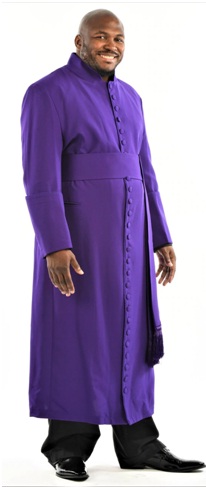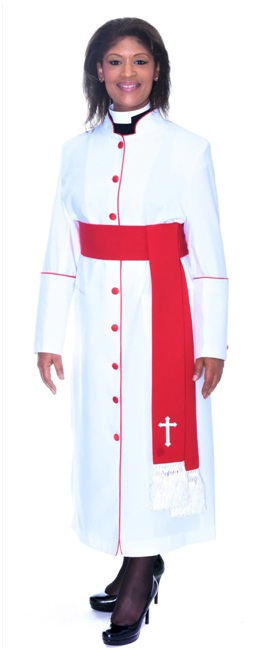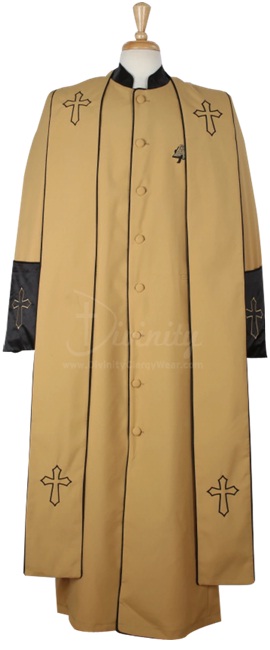Color Symbolism in Choir Robes, Clergy Robes and other Vestments
Oct 22nd 2020

Whether you come to Divinity Clergy Wear in search of choir robes, a tab collar clergy shirt, a robe and stole set, or something more unique and specialized, one thing is certain. What is certain beyond a doubt that regardless of the vestment or other clerical garment you are looking for, you are nearly sure to find it here.
In fact, you are more than nearly sure to find it here, because you’ll probably find what you’re looking for in like ten or twenty different styles, simply because we pride ourselves on the customer experience. There are times when a black cassock and cincture are appropriate for a setting, but then there are times when you might have wanted to present in something a little more influential, perhaps even brighter.
Speaking of a black cassock and cincture, what wasn’t so apparent about Divinity Clergy Wear is the other, lesser known fact that we are a font of information. On the note of the black cassock and cincture, there is a reason that they are nearly always black, which we will get to shortly.
If you have ever found yourself wondering why some iterations of clerical vestments, ranging from choir robes to clergy robes, are more often styled in some colors than others, we hope this article will answer your questions.
Here are some of the more common colors you will find in clerical vestments, why they are so colored, and where they are appropriate. Buckle up and get ready for a crash course in color symbolism in clergy robes.
Black
You may have been familiar enough with the fact that black is a color that is often reserved for mourning, and so it is customary to wear black at funerals. This is largely due to the western cultural tradition that associates black with death - but there are other reasons that black is a very common color in many clerical garments, and it has nothing to do with death.
Rather, it has to do with the fact that black is seen as a somber and serious color, which is the reason that cassocks are often styled in black. It’s not that it is a color of mourning, but rather that black is not bright; it is sobering, humbling, and simple.
Which is, supposedly, the way that a priest was once expected to present. It also helps to note that a garment such as the cassock is not specifically a vestment, because it was actually intended to serve as the everyday-dress of an ordained member of the catholic church, both inside the church and out of it.
The color black was intended to serve as a humble reminder that the priest’s duties were not only holy, but also secular, and that as a man of flesh, he had duties to other men of flesh. In short, it is a reminder that a “holy man” should not forget that he is no holier than the members of his congregation.
Also, the fact that black is a color devoid of “brightness” is another reason that it meets with fitness for such uses. It does not inspire excitation or passion; far from it. Therefore it is a color in vestments that has been adopted not only as nearly universal among cassocks and cinctures but among other vestments as well.
White
White is a color that is nearly as ubiquitous among clergy vestments as black is, if not moreso. In fact, white may even be more popular in certain circles, although for very different reasons from black.

Whereas black is austere and serves as a grave reminder that ordained members of the church have a dual duty - divine and secular - white is bright and hopeful. It is seen in many places as the color of purity, innocence and simplicity, and in this particular arena, white can be seen as a symbol of hope and of the purity of divine love that blesses those who receive it.
White does more than connote the purity of divine love; as white is a very bright color, it is also seen as a color of inspiration, of victory over the darkness and of joy. For this reason, it is fairly common to see white vestments and other garments in attendance at a wide variety of ceremonies. In fact, white is so common in vestments that there are even some who wear white during funerals. To make short of it, although white is a color of joy, victory, hope and purity, there are not many situations in which it would not be fitting to wear.
One other thing to know is that in certain tropical areas and climates, some priests have taken to wearing white instead of black simply for the reason that white reflects light and therefore does not absorb as much energy from the sun. This is an interesting fact, even though it isn’t really a feature of color symbolism.
Red
If there is one ‘true’ color that can stand apace with black and white for how frequently it is used in vestments, then that color is likely red. Red is a color that has long been infused with significance. For as far back as you can find written accounts, you can find ascriptions of red.
Red is the color of so many things that are diversely charged with significance. Finding and settling on one place to start would be difficult. With that in mind, where are few situations wherein white or even black would not be fitting, the same could not be said of red. Though it connotes many different things, its use is more curtailed.
If we were put to one jumping off point, then we might make a note of the fact that red is the color of blood. This might be the reason for most of the significance that lies behind the color red. The savior’s blood was shed in sacrifice, that the rest of humanity that followed him might be saved. Were it not for the spilling of that blood, all humanity would effectively be cursed to eternal damnation - incidentally, red is also the color of fire. It needs very little explanation to see that there is a lot more at work here.
But Christ’s blood is not the only blood that has been spilled and holds significance in the history of the church. As the blood of all men runs red, red is often worn in commemoration of martyred saints and others who have died in the name of the church. As red is also the color of fire, it may be worn as a reminder of the consequences of transgression.
Red is also a color that awakens the spirit of most people, and red is often seen as a color of passion. Red stimulates the senses and awakens excitement, and therefore red is sometimes used stylistically to stir up the spirits of a congregation.
In terms of situations in which red can be used in the church, it is not uncommon for red vestments to be worn in remembrance of martyrs or sacrifices. For this reason, some ordained members of the church choose red vestments on Good Friday to honor the memory of the sacrifice of Christ.
As mentioned, red is a naturally exciting color, and therefore, if you find yourself looking for vestments that have a bit of contemporary flair in place of rigid adherence to tradition, you’re in the right place to find them. You can use red vestments to do justice to the precepts here, but you can also breathe your own style into your presence.
Purple
Purple can give red a run for its money when it comes to prevalence in vestments. The use of purple in clerical processions is an interesting one and probably dates back to before the beginnings of the church.
It is possible that the use of purple in the church is a callback to the Phoenician practice of arraying their nobles with rich purple garments. Because that color was so widely recognized and revered in the ancient world, it has come to us in the present day as the color of royalty. Thus, without further explanation, we see the color purple as the color of kings.
That may be a part of the reason that purple is so often associated with Advent or Lent, when the “King is coming.” This is conjectural, but there may be a grain of truth somewhere in it.
Besides that conjecture, the color purple is very frequently used during masses and other ceremonies where a measure of repentance or reflection is called for. Purple sometimes makes its presence known at funerals, and it is also common for priests presiding over Lent ceremonies to wear purple. This is fitting, as purple is, as mentioned, a color associated with grief, penitence, mournfulness and the hope of absolution.
Blue
Blue, like purple, is also a color that is deeply intimated with impressions of royalty. That’s one of the reasons that we have phrases like royal blue. Either way, blue is a color that, one way or the other, lends a regal impression to the person wearing it.
For this reason, blue is sometimes worn when that is the impression that the wearer wants to make. In addition to this observation, blue is also sometimes seen as the color of the Virgin Mary, and therefore it is sometimes worn on her feast day.

Gold and Silver
Gold and Silver, though they are different colors, sometimes bring the same measure of importance to the wearer. They lack some of the long standing cultural tradition of colors like black, white, red and purple, but all the same, they can be used symbolically during a ceremony.
Perhaps the most noticeable way in which gold or silver can be used is to make a similar impression to royal blue. Gold and silver both, as precious metals, are rare and connote wealth and riches. Therefore, gold and silver, like blue and purple, are the colors of kings.
On a less overtly clerical note, gold and silver, as they are reflective, also seem symbolically as mirrors, and can be used to connote reflection and introspection, on top of royalty.
Most of the time, though, gold and silver can be seen as royal colors and will be used accordingly.
Other Colors
These are only a few of the colors that you might come across in our collection of church vestments, choir robes, stoles and other accessories for men and women. If you want a more succinct version of this article that touches on a few more colors that you might come across, check out our shorter blog on the importance of color in church vestments.
If you still want to learn more than you can find in our blog, make sure you get in touch with us and we’d be glad to fill you in!
Traditional Styles and Colorful Contemporary Appeals, All in One Place!
There you have it - a relatively brief insight into some of the color symbolism that you might come across in a collection of vestments including robes and stoles, choir gowns for church choirs, and preaching dresses and robes for ladies.
There’s one more thing missing, and that’s a reminder that we don’t only have vestments in a wide range of colors. What we also have is a diverse assortment of church vestments and other liturgical garments in a range of styles as well.
For those occasions where austerity bespeaks the most propriety, you can fall back on our traditional assortment of robes, cassocks and other vestments, but we also recognize that that situation does not cover every single situation you might come across.
At any time that you want to inspire your congregation with the freedom of your own spirit, then you will simply love the collection of contemporary vestments we offer as well. Take a look through our catalog to find what’s right for you, and don’t forget to give us a call if you have questions or concerns. You can reach us at 877-453-3535, and we’d be glad to hear from you!